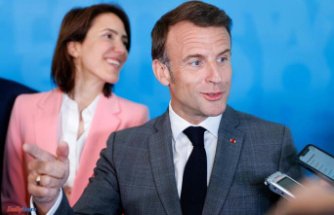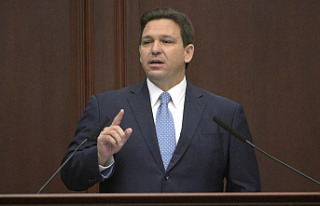However, this measured approach was quickly overthrown by a federal judge who tossed out the federal requirement to mask up mass transit users. As the administration attempts to overcome the virus, the ruling added urgency to the messaging challenge.
The government relaxed indoor mask-wearing guidelines last month for the vast majority Americans, even in schools. Masking on planes was still a redoubt of the national COVID-19 regulations. As the policy is falling, the administration now focuses on accelerating its efforts in order to offer the best advice to millions of people who are trying to make their own safety decisions during the still-dangerous pandemic.
It is both a matter of public health and a significant shift in Biden's focus for his political future.
"There's an opportunity now. Instead of saying that this is a disappointing decision, they could say that this is a good moment to have a discussion about how we move forward with this pandemic risk calculation," Dr. Amesh Adalja, an infectious disease physician who is also a senior scholar at Johns Hopkins Center for Health Security, said.
He said that COVID-19 has given us the ability to build immunity against prior infections, home tests, vaccines and treatments so we can manage it in the same way as other infectious diseases.
Biden was open to flexibility when Biden was asked Tuesday if Americans should wear masks on planes.
Biden stated, "That's up for them," during a visit in Portsmouth, New Hampshire. However, the White House still requires that all passengers on Air Force One wear face covers. This is based on guidance from the Centers for Disease Control and Prevention.
In February, the White House coronavirus team released a 100-page plan that showed how they would shift towards less formal regulation. Administration officials had originally hoped that children younger than 5 years old would be eligible for vaccination. This would have alleviated the concerns of millions of parents and offered protection to almost everyone in the U.S.
Monday's court order to lift the mask mandate was issued at a critical moment in the nation's pandemic response. It came just shy of one year since all Americans were eligible for COVID-19 vaccinations. Although the ruling sent agencies like the White House scrambling for compliance, it didn't stop travelers from experiencing confusion as some airlines and airports removed their mask requirements -- sometimes mid-flight.
Even though the mandate was not yet in effect, the administration reiterated that Americans must still follow CDC's recommendations for wearing face covers. Jen Psaki (Biden's press secretary) stated the same just one hour before Biden made his "upto them" comment.
"The CDC recommends that masks be worn on planes. She stated that we are adhering to the CDC recommendations. The president is also, and she would recommend that all Americans do the same.
Anthony Coley, a Justice Department spokesperson, stated Tuesday that officials believed the federal mask order was validly exercised by Congress to protect public health. He added that it was an important authority the Department will continue working to preserve.
He said that the department would appeal the ruling only if the CDC deemed the mask mandate still necessary to protect public health. Officials said that the agency had not yet made a decision as of Tuesday evening.
Psaki indicated Tuesday that the administration was disappointed by the ruling but it did not rank with Congress' inability of reaching a compromise on additional COVID funds to purchase antiviral treatment and booster shots.
She stated, "Those are our greatest concerns."
The face-covering requirement has been proven to reduce the risk of infection and has become more political in the U.S.A., especially as severe cases have fallen.
Many people were reminded every day by the lingering mandate to use public transportation and air travel, that the pandemic they longed for was not over. Even though vaccinations and antiviral treatment had significantly reduced their risk, it still affected their lives. Others are still afraid of the virus and each rollback of pandemic restrictions has caused new disquiet, some even criticism of the Biden administration.
Psaki stated that "there are still a lot people in this country wanting to have masks in their place -- either they're immunocompromised or they have children under 5 years old, whatever it may be."
Monday's court decision hastened a result that was expected to be in weeks. Many officials in the administration believed that the 15-day extension of last week's mask order until May 3 would be the final. The public health agency requested additional time to determine if a recent increase in infections would lead to increased hospitalizations and deaths. It has not.
The administration was taken by surprise when the court ordered it. It struggled to understand its impact on the future of CDC.
"CDC scientists had requested for 15 days to make a better data-driven durable determination," Dr. Aashish Jha (the new White House COVID-19 coordinator) tweeted Tuesday. We should have given it."
The virus isn’t going away, as evidenced by the recent spike in cases and spate of positive cases in Biden’s orbit (including second gentleman Doug Emhoff, House Speaker Nancy Pelosi).
The White House stated that Biden, 79 years old, was not identified as a "close contacts" according to CDC guidelines. Officials also stressed that he is well protected from the virus because he has been vaccinated twice and is regularly boosted.
Since his election, Biden has made it a top priority to control the virus that has claimed the lives of 986,000 Americans. Now, the U.S. has about 35,000 confirmed cases per daily, down slightly from January's peak of over 806,000, but still higher than the lows of 26,000 a month earlier. These numbers are likely to be undercounted as many people don’t report results from at-home testing to the public health authorities.












